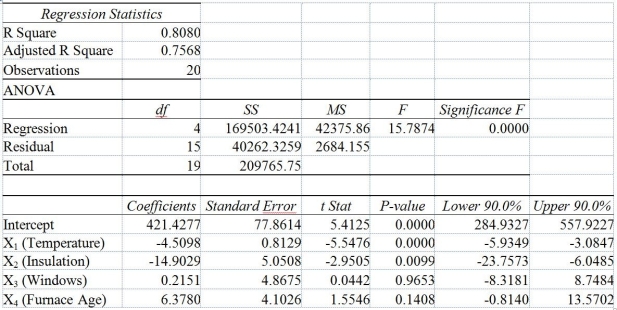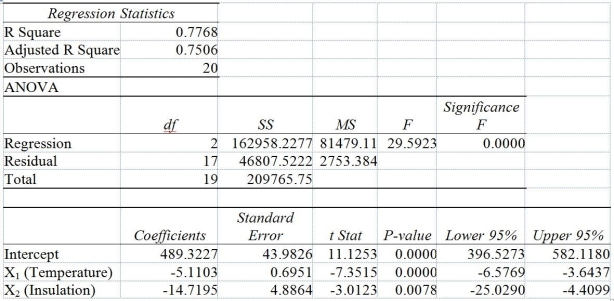
TABLE 14-6
One of the most common questions of prospective house buyers pertains to the cost of heating in dollars (Y) . To provide its customers with information on that matter, a large real estate firm used the following 4 variables to predict heating costs: the daily minimum outside temperature in degrees of Fahrenheit (X₁) the amount of insulation in inches (X₂) , the number of windows in the house (X₃) , and the age of the furnace in years (X₄) . Given below are the Excel outputs of two regression models.
Model 1

Model 2

-Referring to Table 14-6, the estimated value of the partial regression parameter β₁ in Model 1 means that
A) holding the effect of the other independent variables constant, an estimated expected $1 increase in heating costs is associated with a decrease in the daily minimum outside temperature by 4.51 degrees.
B) holding the effect of the other independent variables constant, a 1 degree increase in the daily minimum outside temperature results in a decrease in heating costs by $4.51.
C) holding the effect of the other independent variables constant, a 1 degree increase in the daily minimum outside temperature results in an estimated decrease in mean heating costs by $4.51.
D) holding the effect of the other independent variables constant, a 1% increase in the daily minimum outside temperature results in an estimated decrease in mean heating costs by 4.51%.
Correct Answer:
Verified
Q73: TABLE 14-6
One of the most common questions
Q74: When an additional explanatory variable is introduced
Q75: TABLE 14-5
A microeconomist wants to determine how
Q76: TABLE 14-6
One of the most common questions
Q78: The coefficient of multiple determination r²Y.₁₂ measures
Q79: When an explanatory variable is dropped from
Q80: TABLE 14-5
A microeconomist wants to determine how
Q86: A multiple regression is called "multiple" because
Q87: Multiple regression is the process of using
Q94: When an explanatory variable is dropped from
Unlock this Answer For Free Now!
View this answer and more for free by performing one of the following actions

Scan the QR code to install the App and get 2 free unlocks

Unlock quizzes for free by uploading documents